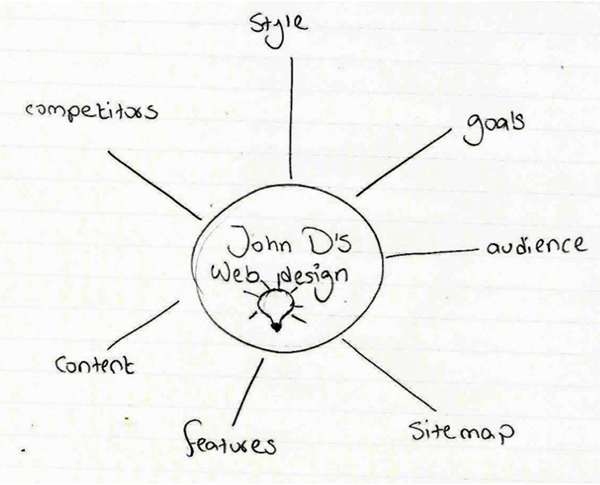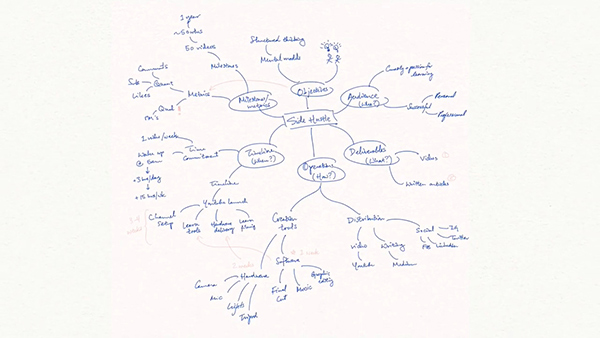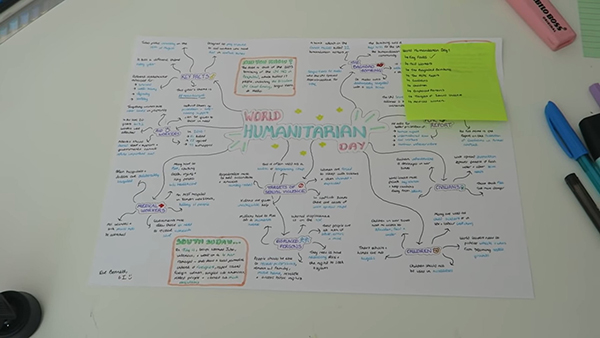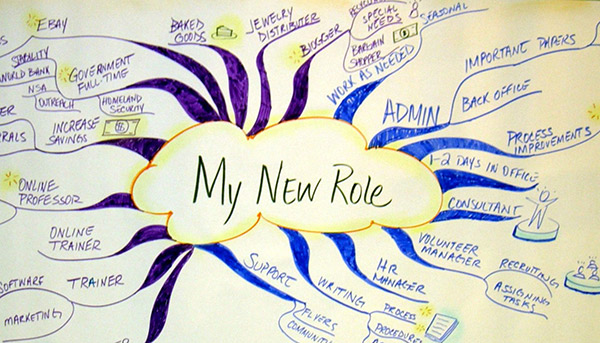They look good and they make your life easier.
They have the potential to become an integral part of organizing your projects, workflow, and even your time.
They’re called Mind Maps.
If you do a quick Google search for examples of mind maps, you’ll be greeted with a host of images that look like they could’ve been created by artists or paid software. At first glance, they might even seem intimidating if you’re in the early stages of your exploration.
But this doesn’t always have to be the case.
The simplest mind maps, if done properly, can streamline your process of dealing with new projects. They can revolutionize the way you strategize your business.
With time and practice, mind mapping can become a powerful tool for freelancers.
In this article, we’ll introduce you to four simple mind map designs that’ll help you get started today.
Example 1: A Mind Map in Under 60 Seconds

This one probably looks very different from all the mind maps you’ve seen on the internet. It might also be one that Tony Buzan won’t approve of. And yet, this is the one you should refer to when you’re getting started with a new client or project.
I like this one because it proves that you don’t have to be a creative genius to make a mind map. It also emphasizes the notion that you shouldn’t get too hung up on how your mind map ends up looking.
You can use a design like this to efficiently summarize your clients’ wants and needs.
Begin by writing down the name of the client or the project in the middle of the paper. Draw a circle around it. Then fill the surrounding area with key points like their expected end-goals. And maybe add a third tier to brainstorm ideas on how to reach the desired results.
Try to do all this in under a minute.
This method will help you move your focus away from spending too much time designing the map. That shouldn’t be your primary objective in the first place.
What’s Good About This Mind Map
- Super quick to start and finish and requires zero preparation
- Requires only a pen and paper to build
- Not intimidating at all since it doesn’t need any artistic talent
What’s Bad About This Mind Map
- Rather visually unstimulating
- Forgettable design
- Unlikely to enhance your creativity
How You Can Improve This Mind Map
- Use different colored pens for the branches and texts
- Put the sub-tiers inside different shapes to make them more distinct
- Add one or two relevant doodles to spur your creativity
Example 2: A Mind Map to Manage Projects

This is an example of another hand-drawn map. It was made by a YouTuber by the name of Sheng Huang — whose video you can watch below.
It’s basically the elder brother of the 60-second mind map. You can use it to delve even deeper into your projects to draw out the finer details. This one is obviously going to take a lot more than 60 seconds.
Like the previous map, start with the central idea in the middle of the paper. Then, surround it with the main elements that you need to figure out; for instance, objectives, target audience, deliverables, operations, timeline, metrics, etc. Break these down even further as you go into the third tier (and beyond).
Notice how he left plenty of room between the branches and texts? This is so that he can come back to it and add more sub-topics or annotations if he wants.
This kind of design is great for organizing your projects, work, and even your thoughts. It’s simple yet effective.
What’s Good About This Mind Map
- Very simple to build
- Uses different shapes to differentiate between the individual tiers
- Has an actionable layout
What’s Bad About This Mind Map
- Lacks colors and images
- Does not leave a memorable impression
How You Can Improve This Mind Map
- Make the branches different colors as you move from one tier to the next
- Accentuate the central idea and sub-topics with images or even different colored highlighters
- Go a little crazy and zhuzh up your fonts
Example 3: A Mind Map to Study Effectively

Above is a mind map by another YouTuber named Eve Bennett — their video is also below.
I included this one on the list because as an online worker, you’re always looking to level up your skills. As you take on courses to learn something new or to revise old materials, you can use this type of mind map to help you effectively take in what you study.
This one is a little on the artsy side. So feel free to loosen the reins on your creative faculties.
For the central idea, she uses big, bold, and colorful fonts that immediately grab your attention. Even the titles stand out because she wrote them in purple and put them inside squiggly outlines.
When it comes to the content, she uses black for the text and occasionally other colors to emphasize certain words. See how she only writes in short sentences? It’s very important that you condense the information you have on hand.
Include only the key ideas.
And lastly, I like how she uses tiny images and brightly-colored shapes every now and then. This makes the map more catchy which in turn allows you to better retain the information.
What’s Good About This Mind Map
- Aesthetically pleasing
- Neatly spaced sections that make the content discernible
- Uses a checklist that contains all the headings
What’s Bad About This Mind Map
- Contains a lot of branches
- Not much available space to later include sub-points or more tiers
- Takes a lot of time to build
How You Can Improve This Mind Map
- Merge branches with similar themes
- Divide the content into two separate maps if you have a lot of information to include
Example 4: A Mind Map to Remember

With this mind map, we are heading a bit more towards the creative side of the craft.
Incorporating images and colors into your mind maps helps maximize the power of your brain. You’ll be able to remember the information for longer with greater clarity.
The boldness of the branches and the substantial size of the headings help make it more engaging. The consequence is a map that leaves a lasting impression.
Start with an attention-grabbing central image for your main idea. Produce branches from it that lead to the second and third tiers. Incorporate more images (relevant or otherwise) and colors where you deem necessary.
I’d suggest that you try making something like this once you’ve built a habit of using mind maps for your daily work. While this kind of map is certainly more memorable, and thus more effective, it may take up an entire afternoon to build.
But you also may find that it was time well spent.
This kind of mind map can prove to be useful when you’ve undertaken a big project that you expect to last for at least a couple of months. A glance at it will remind you of all the things that need to be done.
But what if you don’t have the requisite artistic prowess to build something like this? Don’t worry, there’s plenty of mind mapping software that you can find online. You’ll be able to build something just as efficient and appealing on your computer.
What’s Good About This Mind Map
- Has a captivating design
- Features a prominent central idea
What’s Bad About This Mind Map
- Uses too many branches
- Might be time-consuming to make
How You Can Improve This Mind Map
- Moderate the number of branches
- Emphasize the more important ideas
Start Mind Mapping Today…
Mind mapping is a unique and efficient system for enhancing your creativity and productivity. They can improve memory and retention. Whether you’re a copywriter, blogger, graphic designer, or virtual assistant, you will find an infinite number of uses for this organization method.
Furthermore, mind maps can be a great medium for penning your thoughts and ideas. You can accomplish a great number of things with their help, be it setting your business goals or planning your everyday tasks.
Use these examples as inspiration for building your own mind maps. Follow certain rules like:
- Using colors and images
- Emphasizing key ideas
- Making the central idea and other titles prominent
But, let your mind maps show your personal preferences. Customize them according to your whims. And don’t spend an unnecessary amount of time on their appearance.
To get more ideas on how to take your freelancing career to the next level, visit Small Revolution, an online learning platform. We have an amazing collection of articles on productivity that will help you grow in your industry.
Simply demonstrate your will and Small Revolution will show you the way.


